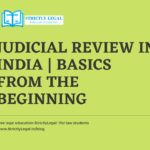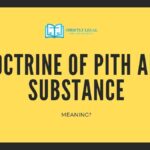Introduction
The Doctrine of Pith and Substance is one of the most important principles in Indian constitutional law. It helps courts decide questions of legislative competence when there is a conflict between the Union List, State List, and Concurrent List under the Seventh Schedule of the Indian Constitution. For UPSC, LLB notes, and law exams, this doctrine is crucial because it explains how federalism in India maintains a balance between the powers of the Union and the States.
In simple words, the doctrine says: If a law is in its true nature (pith and substance) within the power of the legislature which enacted it, it will be valid, even if it incidentally encroaches upon the field assigned to another legislature.
Meaning of Doctrine of Pith and Substance
The meaning of doctrine of pith and substance lies in examining the true character of legislation. The phrase “pith and substance” means the essence of the law.
- Pith = true object.
- Substance = the essential nature of the law.
Thus, the doctrine of pith and substance deals with legislative competence, not legislative motives.
Historical Background
The doctrine was borrowed from Canada, where courts had to resolve conflicts between provincial and federal powers. In India, it was adopted to handle overlaps between Union and State laws.
Doctrine of Pith and Substance in Indian Constitution
Under the Constitution of India, powers of law-making are divided through:
- Union List (Parliament’s powers)
- State List (State Legislatures’ powers)
- Concurrent List (both can legislate, subject to Article 254)
When a law made by one legislature appears to intrude into the field of another, courts apply the doctrine of pith and substance. If in pith and substance, the law falls within the competence of the enacting body, it is held valid.
Difference Between Doctrine of Pith and Substance and Colourable Legislation
- Pith and Substance → checks competence of the legislature.
- Colourable Legislation → checks motive of the legislature (whether it disguised one law as another).
Scope and Relevance
- The doctrine is used to decide conflicts between Union List and State List.
- It applies under interpretation of statutes when overlap occurs.
- It ensures federal flexibility in India.
- It has been referred to in Drishti IAS, Byju’s UPSC notes, and LLB textbooks.
Doctrine of Pith and Substance in Hindi (संविधान में पिथ एंड सब्सटेंस का सिद्धांत)
भारत के संविधान में पिथ एंड सब्सटेंस सिद्धांत का तात्पर्य है कि यदि कोई कानून अपने वास्तविक स्वरूप में उस विधायिका के अधिकार क्षेत्र में आता है जिसने इसे बनाया है, तो वह वैध होगा, भले ही वह आंशिक रूप से किसी अन्य सूची के विषय में हस्तक्षेप करता हो।
Related Doctrines
- Doctrine of Colourable Legislation
- Doctrine of Territorial Nexus
- Doctrine of Occupied Field
UPSC, LLB, and Notes Perspective
- For UPSC: A frequent topic in Polity & Constitution (GS-II, Law Optional).
- For LLB Notes & Assignments: Explaining doctrine with case laws is essential.
- For Projects & Research Papers: Focus on its evolution, scope, and judicial application.
Conclusion
The Doctrine of Pith and Substance is a principle of constitutional interpretation. It preserves the spirit of federalism by preventing unnecessary invalidation of laws due to incidental overlaps. In Indian constitutional law, it remains one of the most relied upon doctrines by the Supreme Court of India.

Passionate about using the law to make a difference in people’s lives. An Advocate by profession.




